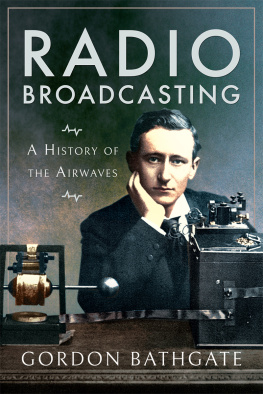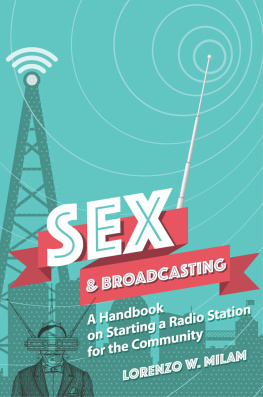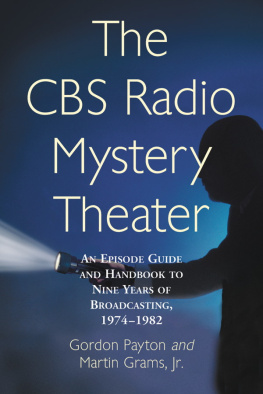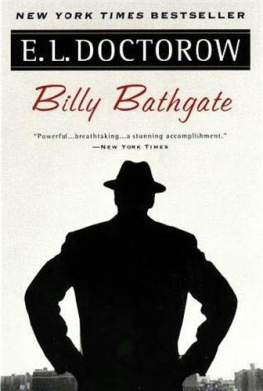Bathgate Gordon - Radio Broadcasting: A History of the Airwaves
Here you can read online Bathgate Gordon - Radio Broadcasting: A History of the Airwaves full text of the book (entire story) in english for free. Download pdf and epub, get meaning, cover and reviews about this ebook. year: 2020, publisher: TECHNOLOGY & ENGINEERING / History, genre: Non-fiction. Description of the work, (preface) as well as reviews are available. Best literature library LitArk.com created for fans of good reading and offers a wide selection of genres:
Romance novel
Science fiction
Adventure
Detective
Science
History
Home and family
Prose
Art
Politics
Computer
Non-fiction
Religion
Business
Children
Humor
Choose a favorite category and find really read worthwhile books. Enjoy immersion in the world of imagination, feel the emotions of the characters or learn something new for yourself, make an fascinating discovery.
- Book:Radio Broadcasting: A History of the Airwaves
- Author:
- Publisher:TECHNOLOGY & ENGINEERING / History
- Genre:
- Year:2020
- Rating:3 / 5
- Favourites:Add to favourites
- Your mark:
- 60
- 1
- 2
- 3
- 4
- 5
Radio Broadcasting: A History of the Airwaves: summary, description and annotation
We offer to read an annotation, description, summary or preface (depends on what the author of the book "Radio Broadcasting: A History of the Airwaves" wrote himself). If you haven't found the necessary information about the book — write in the comments, we will try to find it.
Radio Broadcasting: A History of the Airwaves — read online for free the complete book (whole text) full work
Below is the text of the book, divided by pages. System saving the place of the last page read, allows you to conveniently read the book "Radio Broadcasting: A History of the Airwaves" online for free, without having to search again every time where you left off. Put a bookmark, and you can go to the page where you finished reading at any time.
Font size:
Interval:
Bookmark:

RADIO
BROADCASTING
BROADCASTING
A History of the Airwaves
GORDON BATHGATE

First published in Great Britain in 2020 by
PEN AND SWORD HISTORY
An imprint of
Pen & Sword Books Ltd
Yorkshire Philadelphia
Copyright Gordon Bathgate, 2020
ISBN 978 1 52676 940 4
eISBN 978 1 52676 941 1
Mobi ISBN 978 1 52676 942 8
The right of Gordon Bathgate to be identified as Author of this work has been asserted by him in accordance with the Copyright, Designs and Patents Act 1988.
A CIP catalogue record for this book is available from the British Library.
All rights reserved. No part of this book may be reproduced or transmitted in any form or by any means, electronic or mechanical including photocopying, recording or by any information storage and retrieval system, without permission from the Publisher in writing.
Pen & Sword Books Limited incorporates the imprints of Atlas, Archaeology, Aviation, Discovery, Family History, Fiction, History, Maritime, Military, Military Classics, Politics, Select, Transport, True Crime, Air World, Frontline Publishing, Leo Cooper, Remember When, Seaforth Publishing, The Praetorian Press, Wharncliffe Local History, Wharncliffe Transport, Wharncliffe True Crime and White Owl.
For a complete list of Pen & Sword titles please contact
PEN & SWORD BOOKS LIMITED
47 Church Street, Barnsley, South Yorkshire, S70 2AS, England
E-mail:
Website: www.pen-and-sword.co.uk
Or
PEN AND SWORD BOOKS
1950 Lawrence Rd, Havertown, PA 19083, USA
E-mail:
Website: www.penandswordbooks.com
This book is dedicated to James Clerk Maxwell, Heinrich Hertz and Guglielmo Marconi. Thanks for inventing this marvellous thing called radio, which has given me a lifetime of pleasure and happiness. Thank you to the team at Pen & Sword Books for their help in the preparation of this book. Finally, I am particularly grateful to my long-suffering wife, Karen Oh No! Not another radio Bathgate. Your patience and understanding regarding my radio obsession is greatly appreciated.
On a chilly evening early in 1922, in an old army hut located in a small Essex village, a small, ragtag band of men had gathered. It was St Valentines Day but romantic thoughts had been pushed to the back of their minds. They were preoccupied with something else; something far more important. As the hands of the timepiece on the wall inched slowly forward to 8pm, they scurried around tweaking and adjusting their equipment. Last-minute checks completed, the men waited eagerly to proceed.
This wasnt a crack team of military personnel about to embark on a secret mission. They were a disparate bunch of engineers brought together by an enterprising Italian called Guglielmo Marconi. Under the auspices of his company, they were about to launch Britains first regular radio broadcasting service. At the appointed hour the transmitter and aerial crackled into life.
This experimental station, named 2MT and based at Writtle, a small village near Chelmsford, was the first British radio station to make regular entertainment broadcasts. Transmissions emitted from a hut near to the Marconi laboratories. Initially the station only had 200 watts and transmitted on 428 kilohertz on Tuesdays from 8pm to 8.30pm.
The first transmission was far from a triumph. The signal was weak and the sound was muffled. However, things did gradually improve. These early tests consisted mainly of gramophone records but a live concert was broadcast later.
The station, fronted by the eccentric Captain Peter Pendleton Eckersley, a Marconi engineer, was a surprising success. Eckersley, known as Captain or PPE by his friends, was no shrinking violet and never suffered from the dreaded disease of microphone shyness. His light-hearted enthusiasm effervesced across the ether and pervaded each broadcast.
The station was required to read out its allocated call sign 2MT at regular intervals. The British Army phonetic alphabet was widely used by radio amateurs in 1922; consequently M was Emma and T was Toc, so 2MT became Two Emma Toc. The humorous and glib manner in which Eckersley read out the phonetic version of 2MT resulted in the station being affectionately known as Two Emma Toc.
PPE liked to experiment with sound and would use whatever was lying around to make unusual noises. He would perform spontaneous comedy sketches and improvise operatic parodies. His regular announcement, This is Two Emma Toc, Writtle testing, Writtle testing, delivered in his jocular style, became extremely well known in a very short space of time.
The medium of radio had been established but its genesis had been a prolonged affair. In the late nineteenth century it was clear to numerous scientists that wireless communication was possible. Various theoretical and experimental advancements led to the development of radio and the communication system we know today. The key invention for the beginning of wireless transmission of data using the entire frequency spectrum was the spark-gap transmitter. These devices served as the transmitters for most wireless telegraphy systems for the first three decades of radio.
During its early development, and long after widespread use of the technology, disputes persisted as to the person who could claim sole credit for the invention of radio. Many experiments were running concurrently and across continents. Some scientific theories were merely notional and later verified as unworkable, but they also helped fuel other ideas that did advance technology. There are several men who have been proclaimed the father of radio, but perhaps one simple way to sort out the parentage is to place events in a rough chronological order.
Numerous scientists had posited that electricity and magnetism were linked in some way, but while both are capable of causing attraction and repulsion of objects, they remain distinct effects. In 1802 Gian Domenico Romagnosi proposed the relationship between electric current and magnetism, but his reports were largely ignored.
In 1820 Hans Christian ersted publicly conducted an experiment that demonstrated the relationship between electricity and magnetism in a very simple way. He established that a wire carrying a current could deflect a magnetised compass needle. His initial interpretation was that magnetic effects radiate from all sides of a wire carrying an electric current, as do light and heat. Three months later he began more thorough investigations and subsequently published his findings. ersteds work influenced Andr-Marie Ampres theory of electromagnetism.
The British physicist Michael Faraday had discovered the existence of electromagnetic fields in 1845. After becoming interested in science, Faraday began working with Humphrey Davy, the renowned chemist and inventor. Davy gave Faraday a valuable scientific education and also introduced him to important European scientists.
Faradays greatest contribution to science was in the field of electricity. In 1831 he began a series of experiments in which he discovered electromagnetic induction. Faraday developed the theory that a current flowing in one wire could induce a current in another wire that was not physically connected to the first.
Although Faraday was the first to publish his results, the American scientist Joseph Henry had been working with electromagnetism. Henry had invented a forerunner to the electric doorbell, in particular a bell that could be rung at a distance via an electric wire.
Font size:
Interval:
Bookmark:
Similar books «Radio Broadcasting: A History of the Airwaves»
Look at similar books to Radio Broadcasting: A History of the Airwaves. We have selected literature similar in name and meaning in the hope of providing readers with more options to find new, interesting, not yet read works.
Discussion, reviews of the book Radio Broadcasting: A History of the Airwaves and just readers' own opinions. Leave your comments, write what you think about the work, its meaning or the main characters. Specify what exactly you liked and what you didn't like, and why you think so.









